Composite Materials of Rice Husk and Reed Fibers for Thermal Insulation Plates Using Sodium Silicate as a Binder
Abstract
1. Introduction
2. Materials and Methods
2.1. Materials
2.1.1. Fibers
2.1.2. Binder
2.2. Composition and Preparation of Specimens
2.3. Testing Methods
2.3.1. Thermal Conductivity
2.3.2. Bending Strength
2.3.3. Water Absorption
3. Results and Discussion
3.1. Thermal Conductivity
3.1.1. Rice Husk Plates
3.1.2. Rice Husk and Reed Fiber Plates
3.2. Bending Strength
3.3. Water Absorption
4. Conclusions
Author Contributions
Funding
Institutional Review Board Statement
Informed Consent Statement
Data Availability Statement
Conflicts of Interest
References
- Asdrubali, F.; D’Alessandro, F.; Schiavoni, S. A review of unconventional sustainable building insulation materials. Sustain. Mater. Technol. 2015, 4, 1–17. [Google Scholar] [CrossRef]
- Dikmen, N.; Ozkan, S.T.E. Unconventional Insulation Materials. In Insulation Materials in Context of Sustainability; IntechOpen: London, UK, 2016. [Google Scholar] [CrossRef]
- Melo, A.B.; Barbosa, N.P.; Lima MR, F.; Silva, E.P. Desempenho estrutural de protótipo de alvenaria construída com blocos de terra crua estabilizada. Ambiente Construído 2011, 11, 111–124. [Google Scholar] [CrossRef]
- Mendes, P.F.S. Isolamentos Térmicos em Edifícios e seu Contributo para a Eficiência Energética. Master’s Dissertation, Universidade Fernando Pessoa, Porto, Portugal, 2012. [Google Scholar]
- Mendonça, P. Habitar Sob Uma Segunda Pele: Estratégias para a Redução do Impacto Ambiental de Construções Solares Passivas em Climas Temperados. Ph.D. Thesis, Universidade do Minho, Braga, Portugal, 2005. [Google Scholar]
- Navroski, M.C.; Lippert, D.B.; Camargo, L.; Pereira, M.O.; Haselein, C.R. Avaliação do Isolamento Térmico de Três Diferentes Materiais Usados na Construção e Preenchimento de Paredes Externas. Rev. Ciência Madeira—RCM 2010, 1, 41–51. [Google Scholar] [CrossRef]
- Nunes, L.; Meireles, C.; Gomes, C.P.; Almeida Ribeiro, N. Impacts of Climate Change in Portugal: Common Perception of Causes and Consequences in Forest Development. Res. Ecol. 2019, 1, 45–51. [Google Scholar] [CrossRef]
- Directive (EU) 2010/31 of the European Parliament and of the Council of 10 May 2010 on the Reduction of the Enerdy Performance of Buildings. Available online: https://eur-lex.europa.eu/legal-content/EN/TXT/?uri=CELEX%3A02010L0031-20210101 (accessed on 28 May 2023).
- Chavatal, K.M.S. Relação Entre o Nível de Isolamento Térmico da Envolvente Dos Edifícios e o Potencial de Sobreaquecimento no Verão. Ph.D. Thesis, Universidade do Porto, Porto, Portugal, 2007. [Google Scholar]
- Gonçalves, H.; Graça, J.M. Conceitos Bioclimáticos para os Edifícios em Portugal. FEDER. 2004. Available online: https://repositorio.lneg.pt/bitstream/10400.9/1323/1/Conceitos_20Bioclim%C3%A1ticos.pdf (accessed on 28 May 2023).
- Raimundo, A.M.; Saraiva, N.B.; Oliveira, A.V.M. Thermal insulation cost optimality of opaque constructive solutions of buildings under Portuguese temperate climate. Build. Environ. 2020, 182, 107107. [Google Scholar] [CrossRef]
- Jelle, B.P. Traditional, state-of-the-art and future thermal building insulation materials and solutions—Properties, requirements, and possibilities. Energy Build. 2011, 43, 2549–2563. [Google Scholar] [CrossRef]
- Pacheco-Torgal, F. Eco-efficient construction and building materials research under the EU Framework Programme Horizon 2020. Constr. Build. Mater. 2014, 51, 151–162. [Google Scholar] [CrossRef]
- Zach, J.; Hroudová, J.; Brožovský, J.; Krejza, Z.; Gailius, A. Development of Thermal Insulating Materials on Natural Base for Thermal Insulation Systems. Procedia Eng. 2013, 57, 1288–1294. [Google Scholar] [CrossRef]
- Gaspar, F.; Bakatovich, A.; Davydenko, N.; Joshi, A. Building insulation materials based on agricultural wastes. In Bio-Based Materials and Biotechnologies for Eco-Efficient Construction, 1st ed.; Woodhead Publishing: Southton, UK, 2020; pp. 149–170. [Google Scholar] [CrossRef]
- FAO. Food and Agriculture Organization of the United Nations. 2023. Available online: https://www.fao.org/faostat/en/#data/QCL/visualize (accessed on 28 May 2023).
- Brás, T.F.C. A Utilização da Casca de Arroz Como Carga em Pastas de Preenchimento para a Conservação e Restauro. Master’s Dissertation, Instituto Politécnico de Tomar, Tomar, Portugal, 2020. [Google Scholar]
- Kumar Das, S.; Adediran, A.; Rodrigue Kaze, C.; Mohammed Mustakim, S.; Leklou, N. Production, characteristics, and utilization of rice husk ash in alkali activated materials: An overview of fresh and hardened state properties. Constr. Build. Mater. 2022, 345, 128341. [Google Scholar] [CrossRef]
- Walter, M.; Marchezan, E.; Avila, L.A. Rice: Composition and nutritional characteristics. Ciência Rural 2008, 38, 1184–1192. [Google Scholar] [CrossRef]
- Yarbrough, D.W.; Wilkes, K.E.; Olivier, P.A.; Graves, R.S.; Vohra, A. Apparent Thermal Conductivity Data and Related Information for Rice Hulls and Crushed Pecan Shells. Therm. Conduct. 2005, 27, 222–230. [Google Scholar]
- Rosa, L.C.; Santor, C.G.; Lovato, A.; da Rosa, C.S.; Güths, S. Use of rice husk and sunflower stalk as a substitute for glass wool in thermal insulation of solar collector. J. Clean. Prod. 2015, 104, 90–97. [Google Scholar] [CrossRef]
- Rama, J.P.F. Eco-Painéis Construídos a Partir de Madeira e Resíduos de Palha/Casca de Arroz. Master’s Dissertation, Universidade de Coimbra, Coimbra, Portugal, 2014. [Google Scholar]
- Wang, S.; Li, H.; Zou, S.; Zhang, G. Experimental research on a feasible rice husk/geopolymer foam building insulation material. Energy Build. 2020, 226, 110358. [Google Scholar] [CrossRef]
- Buratti, C.; Belloni, E.; Lascaro, E.; Merli, F.; Ricciardi, P. Rice husk panels for building applications: Thermal, acoustic and environmental characterization and comparison with other innovative recycled waste materials. Constr. Build. Mater. 2018, 171, 338–349. [Google Scholar] [CrossRef]
- Muthuraj, R.; Lacoste, C.; Lacroix, P.; Bergeret, A. Sustainable thermal insulation biocomposites from rice husk, wheat husk, wood fibers and textile waste fibers: Elaboration and performances evaluation. Ind. Crops Prod. 2019, 135, 238–245. [Google Scholar] [CrossRef]
- Aravind, N.; Sathyan, D.; Mini, K.M. Rice husk incorporated foam concrete wall panels as a thermal insulating material in buildings. Indoor Built Environ. 2020, 29, 721–729. [Google Scholar] [CrossRef]
- Marques, B.; Almeida, J.; Tadeu, A.; António, J.; Santos, M.I.; de Brito, J.; Oliveira, M. Rice husk cement-based composites for acoustic barriers and thermal insulating layers. J. Build. Eng. 2021, 39, 102297. [Google Scholar] [CrossRef]
- Fernandes, F.A.d.S.; Costa, D.d.S.d.O.; Martin, C.A.G.; Rossignolo, J.A. Vitreous Foam with Thermal Insulating Property Produced with the Addition of Waste Glass Powder and Rice Husk Ash. Sustainability 2023, 15, 796. [Google Scholar] [CrossRef]
- Abbas, N.; Khalid, H.R.; Ban, G.; Kim, H.T.; Lee, H.K. Silica aerogel derived from rice husk: An aggregate replacer for lightweight and thermally insulating cement-based composites. Constr. Build. Mater. 2019, 195, 312–322. [Google Scholar] [CrossRef]
- Ferrández-García, C.E.; Ferrández-Villena, M.; Ferrández-Cuartero, J.; Ortuño, T.G.; Ferrández-García, M.T.; Andreu-Rodríguez, J. Manufacture and Properties of Three-Layered Low Density Particleboard from Giant Reed. In Proceedings of the International Conference of Agricultural Engineering—CIGR-AgEng, Valencia, Spain, 8–12 July 2014. [Google Scholar]
- Andreu-Rodriguez, J.; Medina, E.; Ferrández-Garcia, M.T.; Ferrández-Villena, M.; Ferrández-Garcia, C.E.; Paredes, C.; Bustamante, M.A.; Moreno-Caselles, J. Agricultural and Industrial Valorization of Arundo donax L. Commun. Soil Sci. Plant Anal. 2013, 44, 598–609. [Google Scholar] [CrossRef]
- Baltrushevich, M. Thermal Insulation Materials Containing Reed Fiber Filler. Master’s Dissertation, Instituto Politécnico de Leiria, Leiria, Portugal, 2020. [Google Scholar]
- Benallel, A.; Tilioua, A.; Ettakni, M.; Ouakarrouch, M.; Garoum, M.; Ahmed Alaoui Hamdi, M. Design and thermophysical characterization of new thermal insulation panels based on cardboard waste and vegetable fibers. Sustain. Energy Technol. Assess. 2021, 48, 101639. [Google Scholar] [CrossRef]
- Shon, C.-S.; Mukashev, T.; Lee, D.; Zhang, D.; Kim, J. Can Common Reed Fiber Become an Effective Construction Material? Physical, Mechanical, and Thermal Properties of Mortar Mixture Containing Common Reed Fiber. Sustainability 2019, 11, 903. [Google Scholar] [CrossRef]
- Siddique, R. Rice Husk Ash. In Waste Materials and By-Products in Concrete, 1st ed.; Springer Science & Business Media: Berlin/Heidelberg, Germany, 2008; Volume 1. [Google Scholar]
- Mejía, L.D. Using wholegrain rice to promote small and medium enterprises. Agric. Food Eng. Technol. 2006, 55, 128–138. [Google Scholar]
- Decreto-Lei no 92/2019 da Presidência do Conselho de Ministros. Lista Nacional de Espécies Invasoras, Diário da República: I Série A, n° 130. 2019. Available online: https://dre.pt/dre/legislacao-consolidada/decreto-lei/2019-124568069 (accessed on 28 May 2023).
- Bialosau, A. Composite Heat-Insulating Materials Based on Natural Raw Materials and Mineral Binders. Master’s Dissertation, Instituto Politécnico de Leiria, Leiria, Portugal, 2017. [Google Scholar]
- Bakatovich, A.; Gaspar, F.; Boltrushevich, N. Thermal insulation material based on reed and straw fibres bonded with sodium silicate and rosin. Constr. Build. Mater. 2022, 352, 129055. [Google Scholar] [CrossRef]
- Sahiron, N.; Rahmat, N.; Hamzah, F. Characterization of sodium silicate derived from sugarcane bagasse ash. Malays. J. Anal. Sci. 2017, 21, 512–517. [Google Scholar] [CrossRef]
- Abo-El-Enein, S.A.; Eissa, M.A.; Diafullah, A.A.; Rizk, M.A.; Mohamed, F.M. Removal of some heavy metals ions from wastewater by copolymer of iron and aluminum impregnated with active silica derived from rice husk ash. J. Hazard. Mater. 2009, 172, 574–579. [Google Scholar] [CrossRef] [PubMed]
- ISO 8301; Thermal Insulation—Determination of Steady-State Thermal Resistance and Related Properties—Heat Flow Meter Apparatus. International Organization for Standardization: Geneva, Switzerland, 1991.
- EN 12089; Thermal Insulating Products for Building Applications—Determination of Tensile Strength Perpendicular to Faces. European Committee for Standardization: Brussels, Belgium, 1999.
- Incropera, F.P.; Bergman, T.L.; Dewitt, D.P. Fundamentos de Transferência de Calor e de Massa, 6th ed.; LTC: Rio de Janeiro, Brazil, 2011. [Google Scholar]
- Bakatovich, A.; Gaspar, F. Composite material for thermal insulation based on moss raw material. Constr. Build. Mater. 2019, 228, 116699. [Google Scholar] [CrossRef]
- Bakatovich, A.; Davydenko, N.; Gaspar, F. Thermal insulating plates produced on the basis of vegetable agricultural waste. Energy Build. 2018, 180, 72–82. [Google Scholar] [CrossRef]
- Neto, C.P.; Seca, A.; Nunes, A.M.; Coimbra, M.A.; Domingues, F.; Evtuguin, D.; Silvestre, A.; Cavaleiro, J.A.S. Variations in chemical composition and structure of macromolecular components in different morphological regions and maturity stages of Arundo donax. Ind. Crops Prod. 1997, 6, 51–58. [Google Scholar] [CrossRef]
- Kabir, M.M.; Wang, H.; Lau, K.T.; Cardona, F. Chemical treatments on plant-based natural fibre reinforced polymer composites: An overview. Compos. B Eng. 2012, 43, 2883–2892. [Google Scholar] [CrossRef]
- Ansolin, A.P. Caracterização da Cana Arundo Donax L. e Avaliação do seu Potencial Como Material de Isolamento Térmico em Portugal. Master’s Dissertation, Universidade do Minho, Braga, Portugal, 2021. [Google Scholar]
- Vitanen, H.; Vinha, J.; Salminen, K.; Ojanen, T.; Peuhkuri, R.; Paajanen, L.; Lähdesmäki, K. Moisture and Bio-Deterioration Risk of Building Materials and Structures. J. Build. Phys. 2010, 33, 201–224. [Google Scholar] [CrossRef]
- Lautkankare, R. Determination of Thermal Conductivity of Reed in TRC of Finland. In Guidebook of Reed Business; Tallinn University of Technology: Tallinn, Estonia, 2013; pp. 28–29. [Google Scholar]
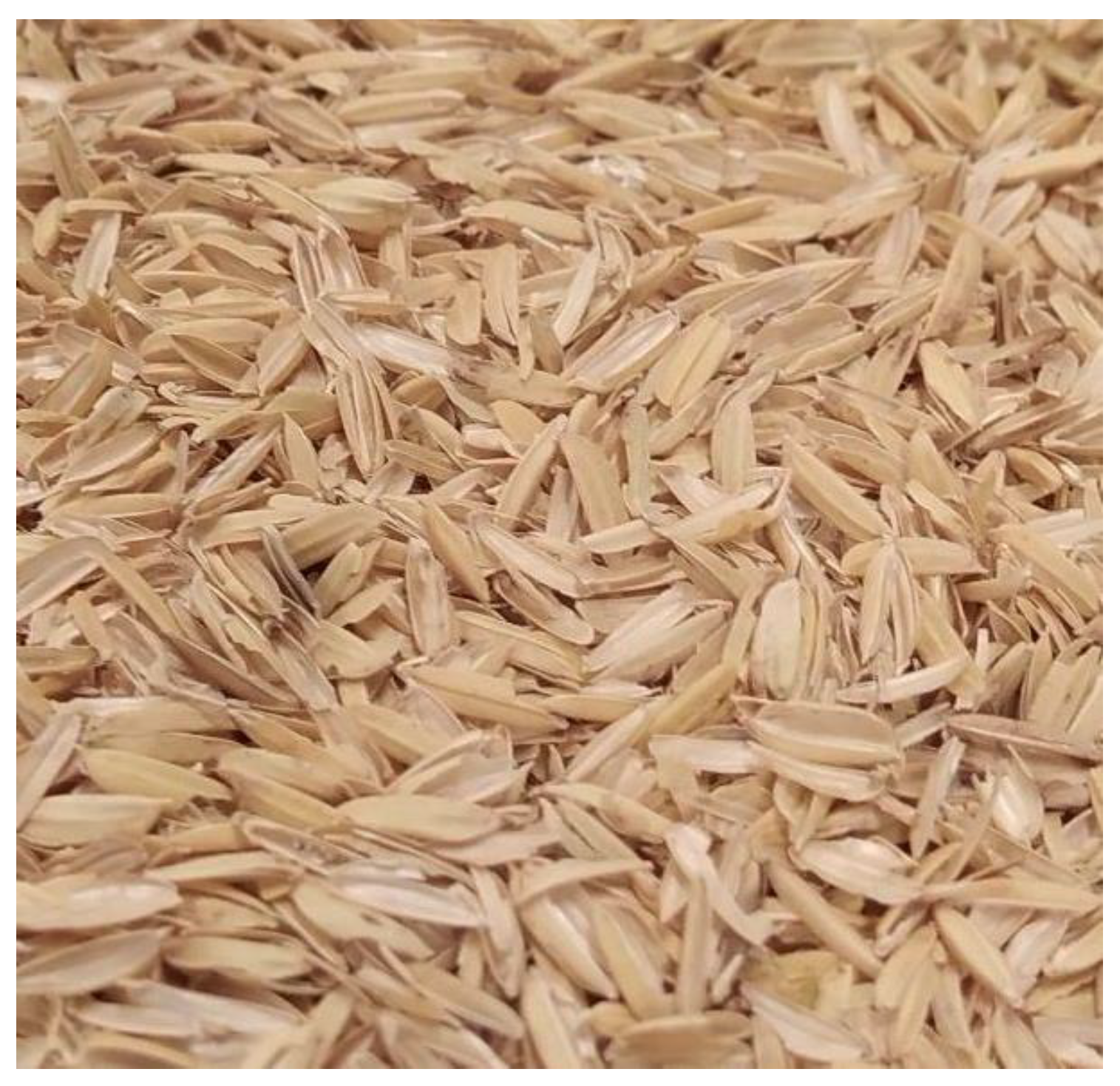



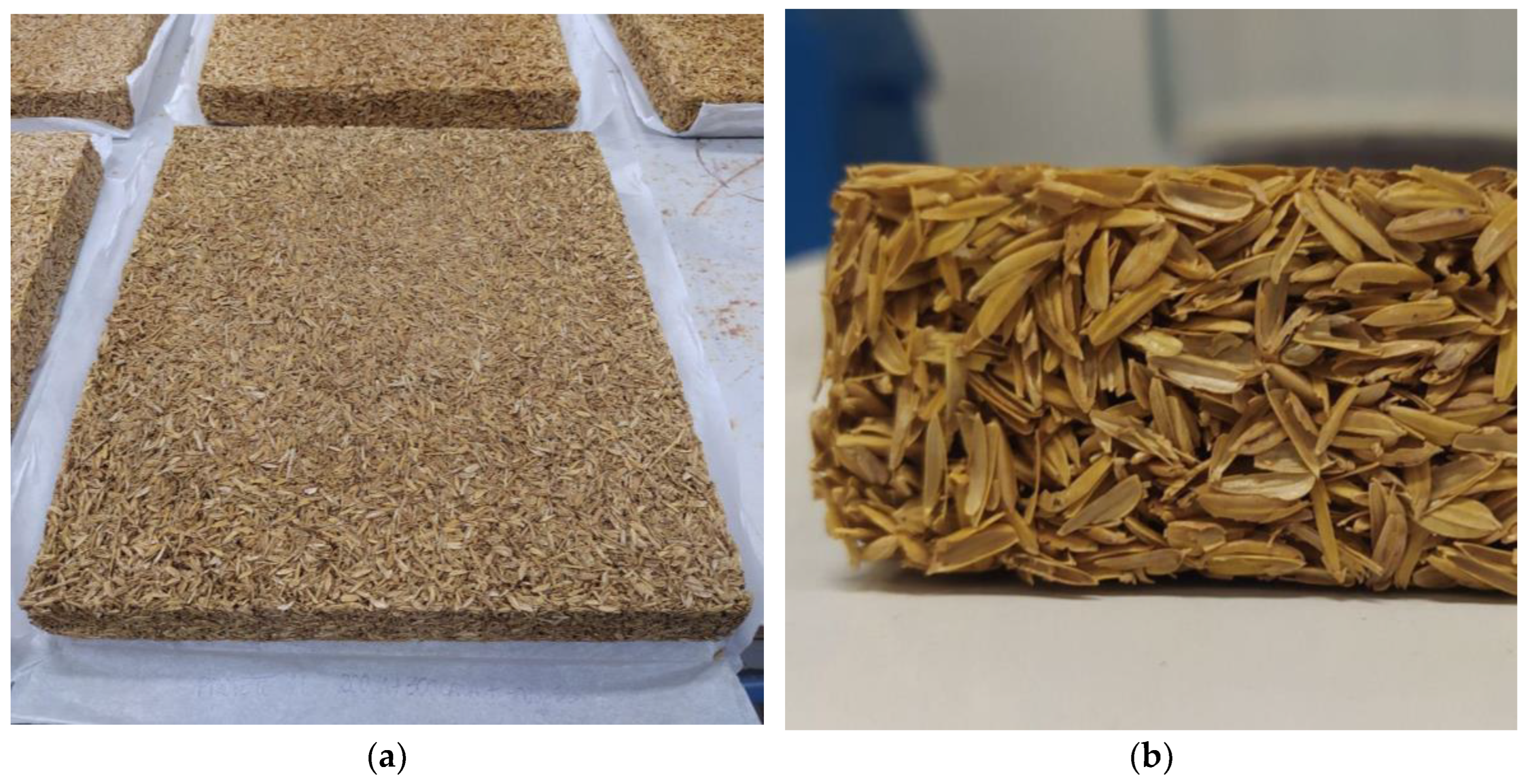
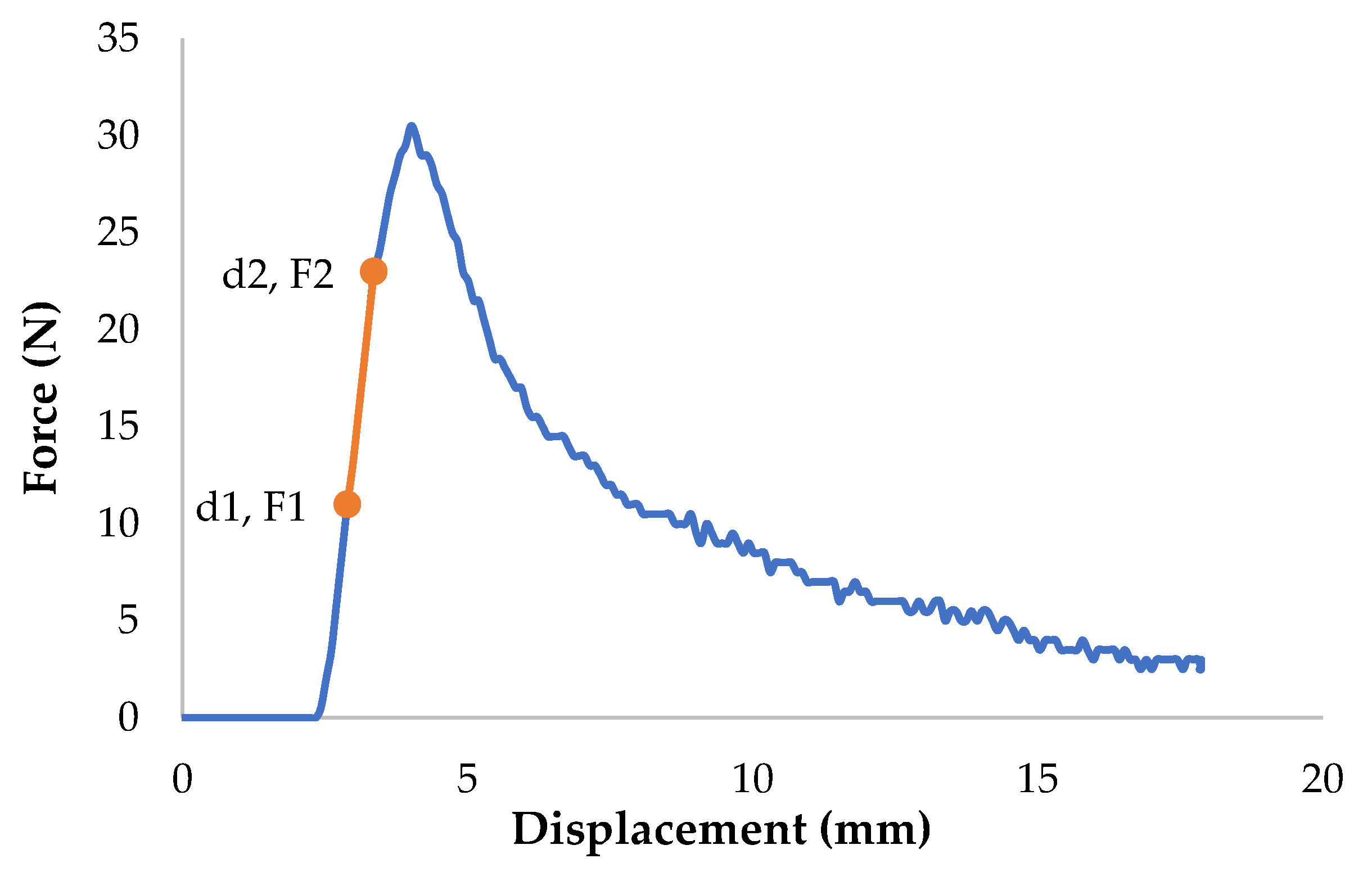
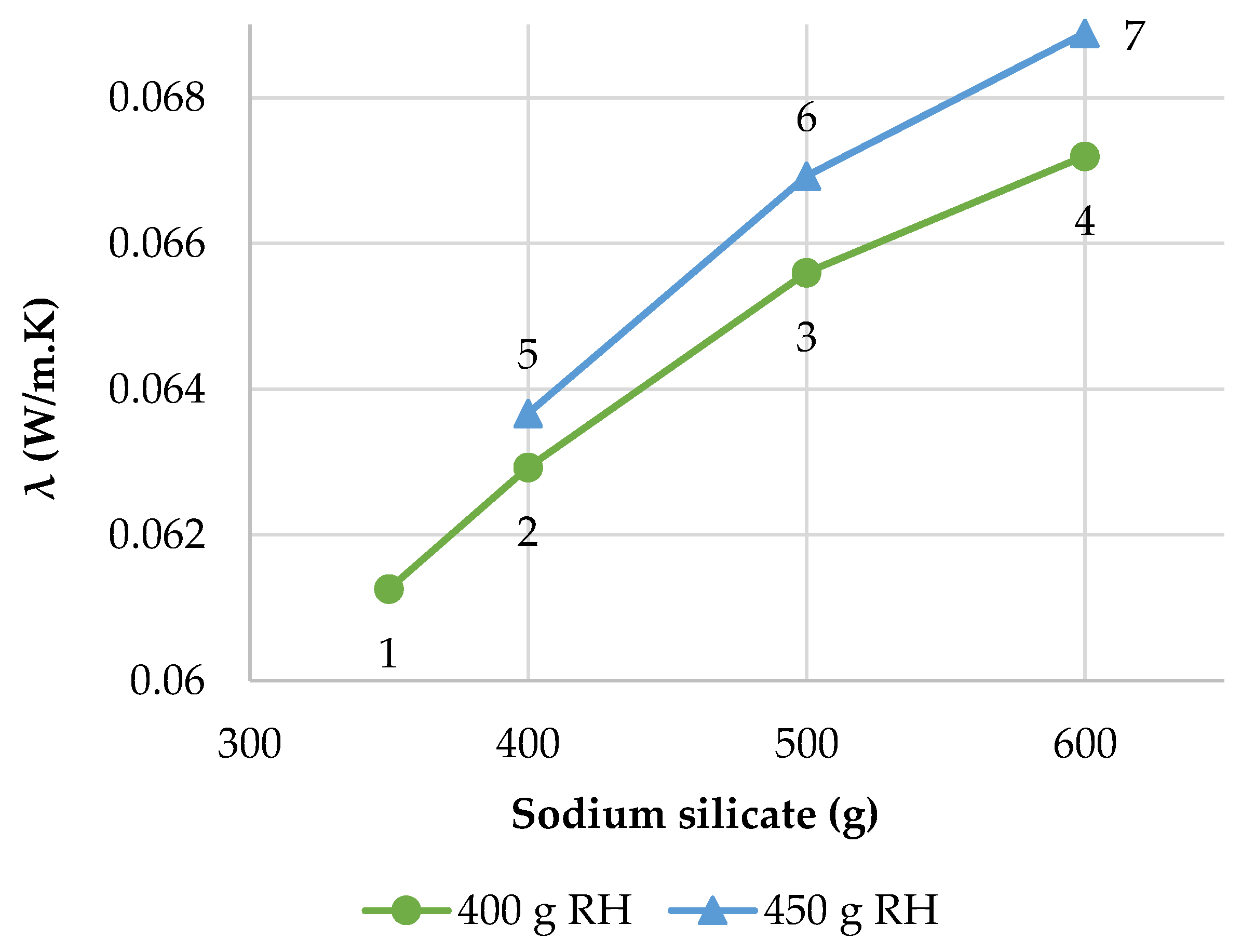
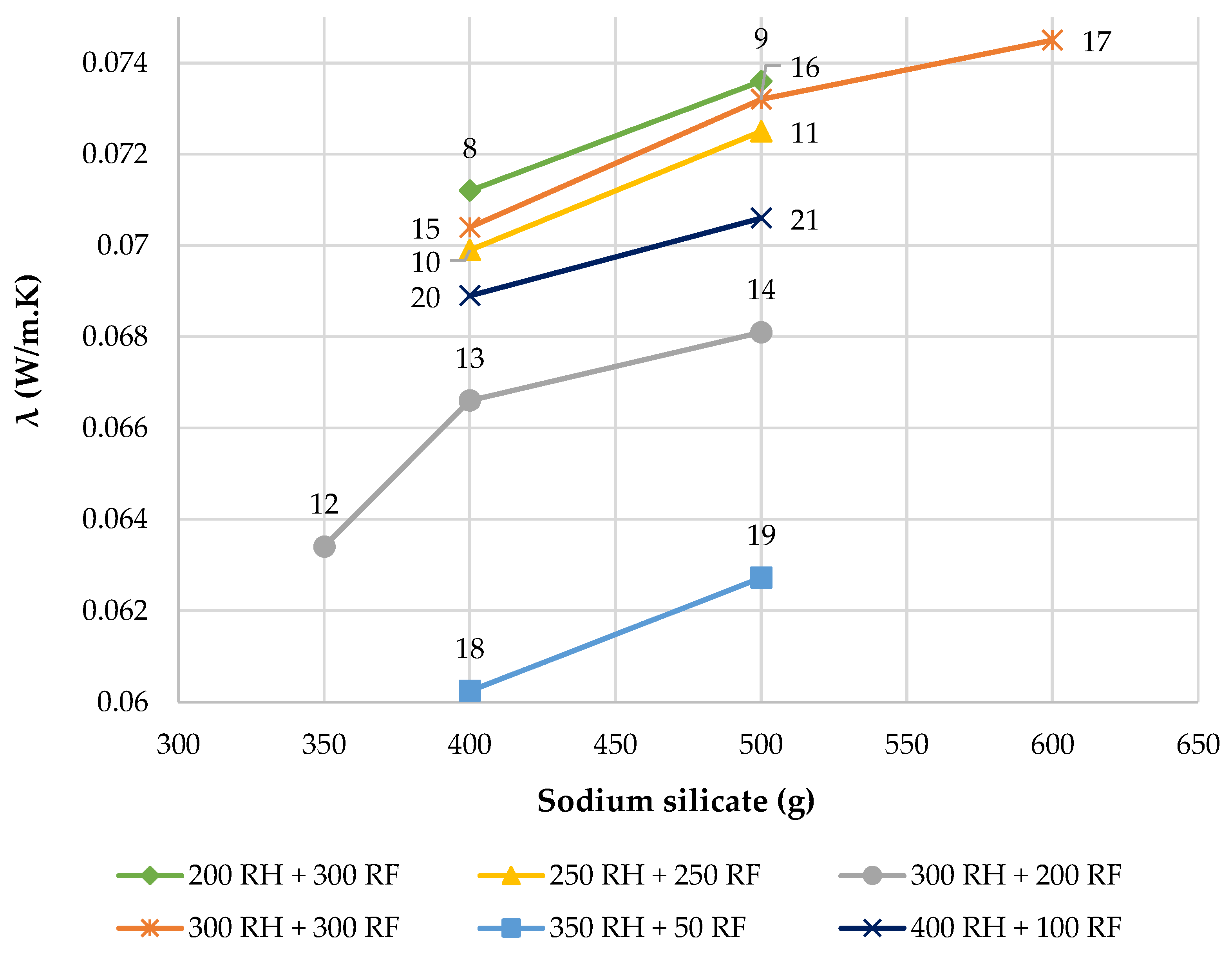
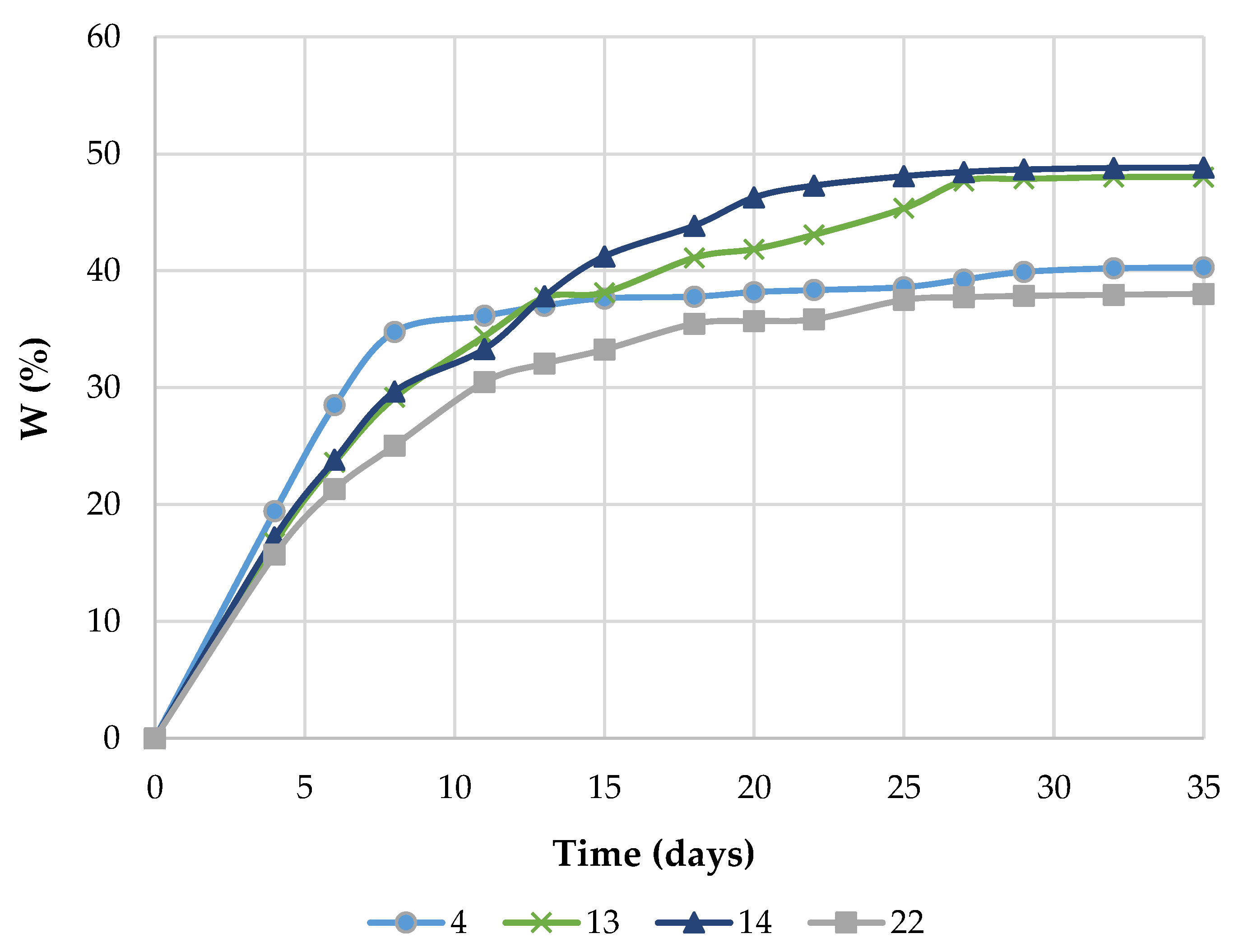

| Size of Particles (mm) | (%) |
|---|---|
| >5 | 10 |
| 2–5 | 30 |
| 1–2 | 28 |
| 0.50–1 | 16 |
| 0.25–0.50 | 10 |
| <0.25 | 6 |
| Sample | Composition (g) | Proportion Aggregatess:Silicate (%) | Dimensions (cm) | ||
|---|---|---|---|---|---|
| Rice Husk | Reed Fiber | Sodium Silicate | |||
| 1 | 400 | - | 350 | 53:47 | 29.8 × 29.8 × 3.0 |
| 2 | 400 | 50:50 | 29.8 × 29.8 × 2.9 | ||
| 3 | 500 | 44:56 | 29.9 × 29.8 × 2.9 | ||
| 4 | 600 | 40:60 | 29.6 × 29.6 × 3.0 | ||
| 5 | 450 | - | 400 | 53:47 | 30.0 × 29.9 × 3.0 |
| 6 | 500 | 47:53 | 29.9 × 29.9 × 3.0 | ||
| 7 | 600 | 43:57 | 29.9 × 29.9 × 3.0 | ||
| 8 | 200 | 300 | 400 | 56:44 | 29.8 × 29.7 × 3.0 |
| 9 | 500 | 50:50 | 29.6 × 29.7 × 3.0 | ||
| 10 | 250 | 250 | 400 | 56:44 | 30.0 × 29.9 × 3.0 |
| 11 | 500 | 50:50 | 30.0 × 29.9 × 3.0 | ||
| 12 | 300 | 200 | 350 | 59:41 | 29.8 × 29.8 × 3.0 |
| 13 | 400 | 56:44 | 29.8 × 29.8 × 3.0 | ||
| 14 | 500 | 50:50 | 29.7 × 29.8 × 3.0 | ||
| 15 | 300 | 300 | 400 | 60:40 | 29.8 × 29.8 × 3.0 |
| 16 | 500 | 55:45 | 30.0 × 29.9 × 3.0 | ||
| 17 | 600 | 50:50 | 29.9 × 29.9 × 3.0 | ||
| 18 | 350 | 50 | 400 | 50:50 | 29.8 × 29.8 × 3.0 |
| 19 | 500 | 44:56 | 29.8 × 29.8 × 3.0 | ||
| 20 | 400 | 100 | 400 | 56:44 | 29.9 × 29.9 × 3.0 |
| 21 | 500 | 50:50 | 29.9 × 29.9 × 3.0 | ||
| 22 | - | 800 | 400 | 67:33 | 30.0 × 29.9 × 3.0 |
| Test | Parameters | No. of Compositions | No. of Specimens per Composition |
|---|---|---|---|
| Heat flow | Thermal conductivity | 22 | 5 |
| Bending | Bending strength, modulus of elasticity | 22 | 5 |
| Water absorption | Moisture content | 10 | 3 |
| Sample | Composition (g) | Density (g/cm3) | Thermal Conductivity (W/mK) | Plate Condition | |
|---|---|---|---|---|---|
| Rice Husk | Sodium Silicate | ||||
| 1 | 400 | 350 | 0.240 | 0.0613 | Not-rigid |
| 2 | 400 | 0.245 | 0.0629 | Semi-rigid | |
| 3 | 500 | 0.257 | 0.0656 | Rigid | |
| 4 | 600 | 0.268 | 0.0672 | Rigid | |
| 5 | 450 | 400 | 0.255 | 0.0637 | Semi-rigid |
| 6 | 500 | 0.273 | 0.0669 | Rigid | |
| 7 | 600 | 0.280 | 0.0689 | Rigid | |
| Sample | Composition (g) | Density (g/cm3) | Thermal Conductivity (W/mK) | Plate Condition | ||
|---|---|---|---|---|---|---|
| Rice Husk | Reed Fiber | Sodium Silicate | ||||
| 8 | 200 | 300 | 400 | 0.269 | 0.0712 | Semi-rigid |
| 9 | 500 | 0.299 | 0.0736 | Rigid | ||
| 10 | 250 | 250 | 400 | 0.275 | 0.0699 | Semi-rigid |
| 11 | 500 | 0.297 | 0.0726 | Rigid | ||
| 12 | 300 | 200 | 350 | 0.254 | 0.0634 | Not-rigid |
| 13 | 400 | 0.273 | 0.0666 | Semi-rigid | ||
| 14 | 500 | 0.302 | 0.0681 | Rigid | ||
| 15 | 300 | 300 | 400 | 0.288 | 0.0704 | Semi-rigid |
| 16 | 500 | 0.323 | 0.0732 | Rigid | ||
| 17 | 600 | 0.352 | 0.0745 | Rigid | ||
| 18 | 350 | 50 | 400 | 0.219 | 0.0602 | Semi-rigid |
| 19 | 500 | 0.240 | 0.0627 | Rigid | ||
| 20 | 400 | 100 | 400 | 0.255 | 0.0689 | Semi-rigid |
| 21 | 500 | 0.273 | 0.0706 | Rigid | ||
| 22 | - | 800 | 400 | 0.270 | 0.0983 | Rigid |
| Sample | Composition (g) | Fmax (N) | E (MPa) | ||
|---|---|---|---|---|---|
| Rice Husk | Sodium Silicate | ||||
| 1 | 400 | 350 | 27.50 | 0.17 | 16.40 |
| 2 | 400 | 33.50 | 0.23 | 47.50 | |
| 3 | 500 | 33.67 | 0.24 | 45.70 | |
| 4 | 600 | 35.67 | 0.25 | 32.94 | |
| 5 | 450 | 400 | 34.83 | 0.23 | 26.29 |
| 6 | 500 | 33.25 | 0.28 | 42.36 | |
| 7 | 600 | 40.25 | 0.29 | 45.05 | |
| Sample | Composition (g) | Fmax (N) | E (MPa) | |||
|---|---|---|---|---|---|---|
| Rice Husk | Reed Fiber | Sodium Silicate | ||||
| 8 | 200 | 300 | 400 | 17.50 | 0.12 | 19.45 |
| 9 | 500 | 21.33 | 0.13 | 23.69 | ||
| 10 | 250 | 250 | 400 | 19.00 | 0.13 | 20.56 |
| 11 | 500 | 25.25 | 0.16 | 27.62 | ||
| 12 | 300 | 200 | 350 | 16.83 | 0.12 | 16.45 |
| 13 | 400 | 19.33 | 0.13 | 28.67 | ||
| 14 | 500 | 25.83 | 0.17 | 36.45 | ||
| 15 | 300 | 300 | 400 | 22.75 | 0.15 | 21.15 |
| 16 | 500 | 32.33 | 0.22 | 31.59 | ||
| 17 | 600 | 34.17 | 0.25 | 29.86 | ||
| 18 | 350 | 50 | 400 | 18.25 | 0.12 | 20.46 |
| 19 | 500 | 19.00 | 0.13 | 26.50 | ||
| 20 | 400 | 100 | 400 | 28.50 | 0.18 | 17.25 |
| 21 | 500 | 32.75 | 0.22 | 31.54 | ||
| 22 | - | 800 | 400 | 16.33 | 0.11 | 14.66 |
| Sample | Composition (g) | Wm Media (%) | ||
|---|---|---|---|---|
| Rice Husk | Reed Fiber | Sodium Silicate | ||
| 2 | 400 | - | 400 | 45.03 |
| 3 | 500 | 43.77 | ||
| 4 | 600 | 40.27 | ||
| 5 | 450 | - | 400 | 43.75 |
| 6 | 500 | 46.83 | ||
| 13 | 300 | 200 | 400 | 47.83 |
| 14 | 500 | 48.44 | ||
| 16 | 300 | 300 | 500 | 45.67 |
| 17 | 600 | 44.33 | ||
| 22 | - | 800 | 400 | 38.02 |
Disclaimer/Publisher’s Note: The statements, opinions and data contained in all publications are solely those of the individual author(s) and contributor(s) and not of MDPI and/or the editor(s). MDPI and/or the editor(s) disclaim responsibility for any injury to people or property resulting from any ideas, methods, instructions or products referred to in the content. |
© 2023 by the authors. Licensee MDPI, Basel, Switzerland. This article is an open access article distributed under the terms and conditions of the Creative Commons Attribution (CC BY) license (https://creativecommons.org/licenses/by/4.0/).
Share and Cite
Silva, A.; Gaspar, F.; Bakatovich, A. Composite Materials of Rice Husk and Reed Fibers for Thermal Insulation Plates Using Sodium Silicate as a Binder. Sustainability 2023, 15, 11273. https://doi.org/10.3390/su151411273
Silva A, Gaspar F, Bakatovich A. Composite Materials of Rice Husk and Reed Fibers for Thermal Insulation Plates Using Sodium Silicate as a Binder. Sustainability. 2023; 15(14):11273. https://doi.org/10.3390/su151411273
Chicago/Turabian StyleSilva, Alana, Florindo Gaspar, and Aliaksandr Bakatovich. 2023. "Composite Materials of Rice Husk and Reed Fibers for Thermal Insulation Plates Using Sodium Silicate as a Binder" Sustainability 15, no. 14: 11273. https://doi.org/10.3390/su151411273
APA StyleSilva, A., Gaspar, F., & Bakatovich, A. (2023). Composite Materials of Rice Husk and Reed Fibers for Thermal Insulation Plates Using Sodium Silicate as a Binder. Sustainability, 15(14), 11273. https://doi.org/10.3390/su151411273







